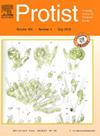Characterization of the encystment-inducing activity of extracellular fluid from encysting vegetative cells in the terrestrial ciliated protozoa Colpoda cucullus
IF 2.1
3区 生物学
Q4 MICROBIOLOGY
引用次数: 0
Abstract
The terrestrial ciliated protozoan Colpoda cucullus transforms into a dehydration-resistant cyst upon sensing adverse signals. Recently, we identified a pheromone secreted by encysting vegetative cells of C. cucullus, termed “encystment-inducing pheromone” (EnIP), and characterized its properties. Overpopulated vegetative cells spontaneously encysted in ion-free ultrapure water without external stimuli. The external solution of encysting cells markedly induced encystment in vegetative cells under low cell density conditions, suggesting that EnIP, secreted by encysting cells into the external solution, induced encystment in vegetative cells. Further investigations revealed the following properties of EnIP: 1) EnIP retains encystment-inducing activity even in the presence of EGTA. 2) EnIP exhibits a concentration-dependent encystment effect. 3) EnIP is released within hours at high cell density. 4) EnIP is released by exocytosis. 5) EnIP loses its activity after 1–2 days. 6) EnIP is inactivated by heating and treatment with proteolytic enzymes. 7) The nominal molecular weight of EnIP was estimated to range between 10 and 100 kDa. These findings lead to the conclusion that encystment-induced C. cucullus vegetative cells secrete EnIP, a protein pheromone, with encystment-inducing activity for other cells. This study contributes to understanding microbial communication and reveals a novel mechanism for protist survival in harsh environments.
陆地纤毛原生动物包囊营养细胞胞外液诱导包囊活性的研究
陆生纤毛原生动物囊足(Colpoda cucullus)在感知到不利信号后转变为抗脱水囊。最近,我们鉴定了一种由黄瓜营养细胞囊化分泌的信息素,称为“囊化诱导信息素”(EnIP),并对其性质进行了表征。在没有外界刺激的情况下,过剩的营养细胞自发地包裹在无离子的超纯水中。在低细胞密度条件下,囊泡细胞外源性溶液显著诱导营养细胞成囊,说明囊泡细胞分泌EnIP诱导营养细胞成囊。进一步的研究揭示了EnIP的以下特性:1)即使在EGTA存在的情况下,EnIP也能保持诱导系统的活性。2) EnIP表现出浓度依赖的囊化效应。3) EnIP以高细胞密度在数小时内释放。4) EnIP通过胞吐作用释放。5) EnIP在1-2天后失去活性。6) EnIP通过加热和蛋白水解酶处理灭活。7)估计EnIP的标称分子量在10 - 100 kDa之间。这些发现表明,囊化诱导的黄瓜营养细胞分泌一种蛋白信息素EnIP,对其他细胞具有囊化诱导活性。该研究有助于理解微生物的交流,揭示了原生生物在恶劣环境下生存的新机制。
本文章由计算机程序翻译,如有差异,请以英文原文为准。
求助全文
约1分钟内获得全文
求助全文
来源期刊

Protist
生物-微生物学
CiteScore
3.60
自引率
4.00%
发文量
43
审稿时长
18.7 weeks
期刊介绍:
Protist is the international forum for reporting substantial and novel findings in any area of research on protists. The criteria for acceptance of manuscripts are scientific excellence, significance, and interest for a broad readership. Suitable subject areas include: molecular, cell and developmental biology, biochemistry, systematics and phylogeny, and ecology of protists. Both autotrophic and heterotrophic protists as well as parasites are covered. The journal publishes original papers, short historical perspectives and includes a news and views section.
 求助内容:
求助内容: 应助结果提醒方式:
应助结果提醒方式:


